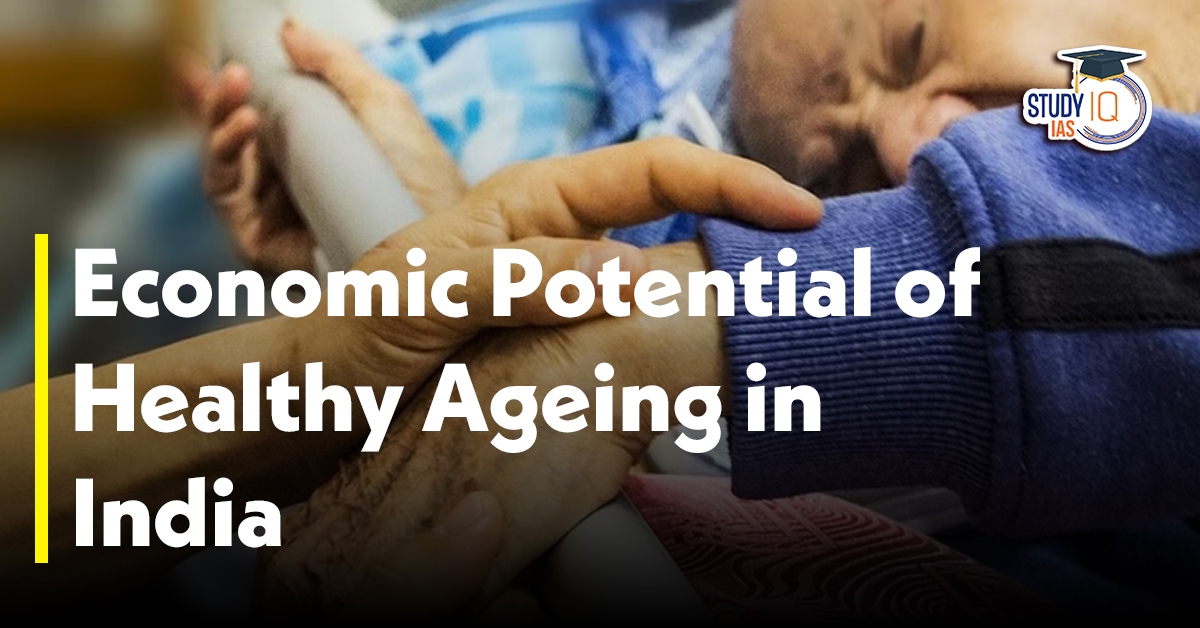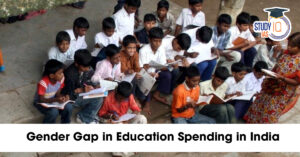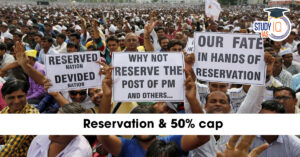Table of Contents
Context: The IMF’s World Economic Outlook (2025) highlights both the challenges and economic potential of healthy ageing in ageing societies like India.
Key Demographic Trends of Healthy Ageing in India
| Metric | Data |
| Elderly Population (2031 Projection) | 13.1% of the total population (up from 8.6% in 2011) |
| Annual Growth Rate of Elderly | 3.28% |
| States with Higher Elderly Population | Kerala (12.6%), Goa (11.2%), Punjab (10.3%), Tamil Nadu, AP, HP |
Workforce Participation in India Trends
| Segment | 2017–18 PLFS | 2023–24 PLFS | Change |
| Overall (Age 65+) | 21.4% | 26.8% | ↑ 5.4% |
| Rural Elderly LFPR | 23.8% | 31.2% | ↑ 7.4% |
| Urban Elderly LFPR | 16% | 16% | No Change |
| Rural Elderly Women | – | ↑ 10.5% pts | |
| Rural Elderly Men | – | ↑ 5.2% pts | |
| Urban Elderly Men | – | Decline | |
| Urban Elderly Women | – | Slight ↑ |
Economic Potential of Healthy Ageing in India: Key Challenges
- Economic Drag: Ageing could reduce India’s GDP growth by 70 basis points (2025–2050).
- Rising Costs: Increasing burden on healthcare and pension systems.
- Gender Disparity: Female Labour Force Participation Rate (LFPR) is still below the global average (41.7% in 2023–24 vs 50% global).
Other Challenges
- Involuntary Work: Many elderly people continue working out of economic compulsion rather than choice.
- Sectoral Disparity: 81% of rural elderly are in agriculture/allied activities.
- Urban elderly are more engaged in diversified sectors (only 23% in agriculture).
- Low Skill Development: Unemployed elderly spend zero time on learning; lack of upskilling pathways.
- Limited Diversification: No increase in manufacturing/industrial jobs for the elderly; services sector involvement declining.
Opportunities for Healthy Ageing People in India
| Area | Explanation |
| Healthier Older Cohorts | 70-year-olds in 2022 showed cognitive levels of 53-year-olds in 2000. |
| Extended Work Life | Better health allows longer working years → higher productivity. |
| Economic Gain | Healthy ageing may add 60 bps to India’s GDP growth by 2050. |
| Technology & AI | AI used in retinal screening shows potential for preventive healthcare. |
| Pension Reforms | NPS promoted fiscal discipline; reverting to old schemes is unsustainable. |
| Female LFPR Boost | Targeting gender parity in the workforce is crucial for the demographic dividend. |
India’s Initiatives for the Elderly Population
- SACRED Portal (Senior Able Citizens for Re-Employment in Dignity) – A job platform connecting senior citizens with private employers for dignified re-employment opportunities.
- SAGE (Seniorcare Aging Growth Engine) – Supports startups offering products and services for elderly care, aiming to build a robust elderly care ecosystem.
- Elder Line (Toll-Free Number: 14567) – A national helpline providing free information, guidance, emotional support, and intervention in cases of abuse or neglect of elderly persons.
- Integrated Programme for Older Persons (IPOP) – Offers financial assistance to NGOs for setting up and running old age homes, day care centres, and mobile medical units for elderly welfare.
- Rashtriya Vayoshri Yojana (RVY) – Provides assistive devices (like walking sticks, wheelchairs, hearing aids) free of cost to elderly individuals below the poverty line.
- Indira Gandhi National Old Age Pension Scheme (IGNOAPS) – Provides a monthly pension to elderly persons (60+ years) living below the poverty line, under the NSAP scheme.
- Pradhan Mantri Vaya Vandana Yojana (PMVVY) – A pension scheme for senior citizens (60+) offering assured returns through LIC for 10 years.
- Vayoshreshtha Samman – A national award conferred by the Ministry of Social Justice and Empowerment to honour senior citizens and institutions working for elderly welfare.
- Maintenance and Welfare of Parents and Senior Citizens Act (MWPSC), 2007 – Mandates children or heirs to maintain their elderly parents and provides for the establishment of old age homes and tribunals for elderly protection.
|
Key Global Models That Harness The Potential Of The Elderly Workforce |
||||
| Country | Model/Program | Key Features | Target Sector/Group | Impact |
| Japan | Senior Human Resource Centres (SHRCs) | ➔ Part-time, flexible jobs for seniors
➔ Job matching ➔ Re-employment policies |
Retirees in community & clerical work | High elderly LFPR (~25% for 65+); promotes social & economic participation |
| United States | Encore Careers Program | ➔ Second careers with social impact
➔ Fellowships and mentoring programs |
Retirees entering education, healthcare, NGOs | Utilises experience for social good; encourages purposeful ageing |
| Germany | Partial Retirement & Flexible Age | ➔ Gradual workload reduction
➔ Pension incentives for extended work |
Older employees in the formal sector | Smooth transition to retirement; knowledge retention in the workforce |
| Sweden | Delayed Retirement Incentives | ➔ Higher pension for later retirement
➔ Inclusive workplace practices |
Employees over 65 | Encourages productive ageing; reduces pension burden |
| Singapore | Senior Employment Credit Scheme | ➔ Wage subsidies to employers
➔ Raised retirement & re-employment age |
Older workers (above 55–60) | Sustains employment of senior workers; reduces age-based job insecurity |
Way Forward
- Change Retirement Age: Align retirement age with rising life expectancy.
- Utilize Experience: Retired professionals (e.g., ex-army) in security, strategy, and mentorship
- Global Models: Japan’s SHRCs, US Encore Careers, Sweden’s flexible retirement
- Workplace Innovation: Promote age-friendly and flexible work environments
- Skilling & Education: Create opportunities for reskilling and lifelong learning
- Social Security: Strengthen Atal Pension Yojana (APY) and National Pension System (NPS), Pradhan Mantri Shram Yogi Maan-Dhan (PM-SYM), MGNREGA, Pradhan Mantri Rojgar Protsahan Yojana (PMRPY), Garib Kalyan Rojgar Abhiyaan (GKRA) etc.
- Entrepreneurship: Encourage elderly-led small businesses and community initiatives.
- Healthcare: Invest in preventive healthcare & AI-based medical screening.
- Gender Equity: Improve gender equity in employment.


 Geo-tagging of Buildings During Upcoming...
Geo-tagging of Buildings During Upcoming...
 Gender Gap in Educational Expenditure in...
Gender Gap in Educational Expenditure in...
 Reservation and 50% Cap: Constitutional ...
Reservation and 50% Cap: Constitutional ...

























